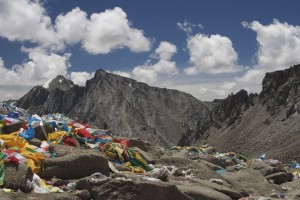Four young Tibetan Bon pilgrims come barreling down the incline. “So, so, so, so, so,” they sing as they run. When they are directly in front of me they raise their hands. “Tashi delek,” they say, “Blessings and good luck.”
I am in western Tibet, on the path leading up to the highest point along the Mount Kailash pilgrimage route, or Kora. I carry my Karma with me— a forty-pound backpack filled with assorted books, clothes, notebooks, snacks; a Canon d550; and a thirty-five-pound tripod. With the aid of two expedition members, I am researching the material culture of pilgrimage— the offerings left by pilgrims along the sacred route around Mount Kailash and the rituals associated with placing these offerings at distinct points along the Kora. The path around the mountain is fifty-three kilometers long. It snakes around boulders, past monasteries, up over a pass, and finally through a valley and along a gorge back to Darchen, the lone town at the mountain’s base. For the past two days we have been trekking up to Drolma La Pass — the apex of the Kora, at 5,636 meters. We have been filming and photographing both the landscape and the pilgrims who pass by.
The Kora is littered with cairns, prayer flags, and articles of clothing. Occasionally, there is blood. The Hindu pilgrims on the route are poorly acclimatised and physically unfit for travel. Lured by tour operators who minimise the consequences of altitude when publicising the pilgrimage trek, they arrive with limited knowledge of the journey. Time and time again, we see men and women on horseback, grey-faced and swaying. Many experience severe nosebleeds and other symptoms of acute altitude sickness. More often than not, these pilgrims have to turn back. We see their suffering litter the Kora in morbid splotches of red.
At the various chaktsel gangs, or sacred prostration points where pilgrims bow to the mountain, mounds of old clothing, offering bowls, and red bull cans create colorful peaks in the landscape. Drolma La Pass is the most sacred point along the Kora. It represents the point of rebirth, at which Drolma La, or Tara, the Mother of Mercy and Bodhisattva of compassion and action, forgives the previous sins of the pilgrims who cross the pass. In the middle of the site a large, square rock juts out of the earth. This rock, the Phawang Mebar, into which the 21 manifestations of Tara are said to have disappeared, is littered with prayer flags. These prayer flags extend across the pass in a carpet of red, green, yellow, and white.
I make my way up the incline toward Drolma La for the second time. The last time I climbed up to the pass, on our first Kora, the wind bit my face and the path was littered with new-fallen snow. This time the rocks are clear; the sky is cornflower blue. The Buddhist pilgrims in front of me bounce up the path, unaffected by altitude and high on spiritual fervour, or perhaps, a combination of red bull and chang, Tibetan beer. Behind me, Lara, the other woman on the expedition, breathes in and out. Her breath keeps time with her feet. I hear her stop to rest, and turn around to find her smiling and gesturing at a young Tibetan Buddhist pilgrim with a baby strapped to her back; the Tibetan woman holds a bright purple umbrella. The baby gurgles. Lara offers the pilgrim a sip of her water, but she declines with a broad smile and instead, makes a gesture to help Lara up the steep path. I hear them progress behind me. I turn to see the woman nod encouragement at Lara before agilely moving up the mountainside. Before long, she passes me, beaming; her face— distilled encouragement.
When I am almost at the top of the pass, the sun hits my back. I find myself gasping for air. Around me Buddhist pilgrims bless the sky with lungtas, or five-inch paper images of the Tibetan ‘windhorse,’ thrown into the air like confetti. Bonpo pilgrims simultaneously sing their mantras and shake strands of prayer flags to honour the sacred mountain. A small urn smokes; the smell of juniper mingles with the clear smell of Kailash.
As I pass a large rock littered with prayer flags and other pilgrims’ mementoes, I see the woman with the purple umbrella. She sits by her baby picking tufts of juniper. The baby is sheltered under the purple arc. When the pilgrim looks up to see me coming towards her she stands and approaches me with a small plastic bag filled with juniper; she gestures at me to watch. She takes the juniper from the bag, rubs it between her fingers, and throws it into the air. “Ah,” she says, “Ah.” Then she gathers a bundle of the savory green shoots and places it in my palm. She carefully closes my hand with her hand, looks right through me, and nods. When her baby begins to wail she turns away, and my gesture of thanks— hands pressed together in prayer position— goes unnoticed.
Drolma La Pass, in the mid-morning, is full of pilgrims. Together we sit— to share snacks, to smile when communication falters, and to watch others learn the landscape. Rebirth is everywhere.




